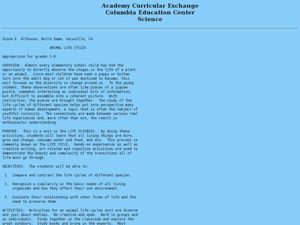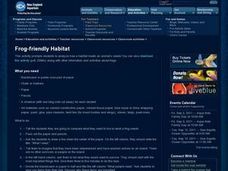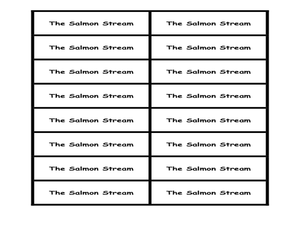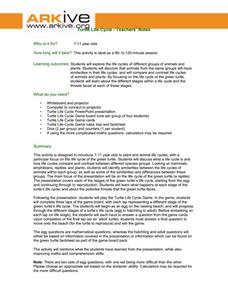Curated OER
What Class Are You In?
Classifying animals has never been this much fun! Pupils discuss the animal groups, fish, reptiles, amphibians, mammals, birds, and also identify their characteristics. Then, they take pictures of animals and classify them in a group...
National Geographic
Rescuing, Relocating, and Rehabilitating Wildlife
Bring up the Deepwater Horizon (BP) oil spill that occurred in the Gulf of Mexico in 2010. Display the colorful diagram of the coastal and marine organisms living in the area. Show a video about relocating the eggs of the Gulf's sea...
Virginia Department of Education
Cell Parts
What do a bird, an egg, a rabbit, and a toad all have in common? This fun-filled resource explains the similarities and differences between cells and how all cells are similar, yet all are different. Learners begin by depicting a...
Curated OER
Animal Signs
Students discuss the many different types of animal signs that can be used to identify and track animals. They participate in an hands-on activity in which they examine tracks, trails, homes, territory markings, and even "scat" left by...
Curated OER
Farm Animals
Learners participate in an activity that reinforces their counting skills and the relationships between numbers, utilizing the concepts of more and fewer. They read in their Math Storybook's about geese at a fair and how those geese are...
Curated OER
Animal Life Cycle
Learners conduct hands-on experiments. In this life cycle lesson, students are able to observe a variety of animals as they travel through their life cycle (brine shrimp, mealworms, frog eggs and chicken eggs). Learners respond to what...
Curated OER
Locating Echo
Students read the book The Adventure of Echo the Bat. In this animal science lesson, students read the book and create a chart labeled "Land Feature," "Habitat," and "Food." Students fill in the table according to where the character...
Curated OER
What Hatches?
In this sight words worksheet, students read a short book about animals catching from eggs. Students may also color in the illustrations.
Curated OER
Animal Facts and Opinions
In this fact and opinion worksheet, learners read 20 informative sentences about animals. Students write "fact" or "opinion" for each sentence.
Curated OER
Frog Friendly Habitat
Students create a frog friendly habitat. In this animal habitat activity, students study what animals need to survive and then create a frog habitat from a shoe box. Students write a report about frogs and present their...
Curated OER
Animal Survey
In this mathematical worksheet, students survey sixteen people to find out if their animals lay eggs or give birth to their young and then graph out their findings.
Curated OER
The Salmon Stream and Vegetation
Students explore the ecosystem and food chain by researching Pacific Salmon. In this fish habitat lesson, students discover the life cycle for salmon, where they spawn and what they eat to survive the harsh elements. Students participate...
Curated OER
Animals Spiral Puzzle
In this animal puzzle instructional activity, students use a set of 8 clues about animals to complete a spiral puzzle. A reference web site is included for additional activities.
Curated OER
4-H Poultry Activity Page: Responsiblity
How many eggs does a chicken lay annually? A poultry project gets 4-H members experiencing the importance of responsibility and care of animals. They read about managing poultry and working with eggs, write a story about their flock,...
Curated OER
Tables
Can you read this table? Learners begin to comprehend data analysis through examining two simple tables and answering comprehension questions. The first gives characteristics about three animals in yes-or-no format (i.e. "eats insects,"...
Curated OER
The Nitrogen Cycle
The nitrogen cycle is the focus of a well-designed science lesson. In it, learners see that plants and animals produce waste products and decompose after death. Many of the waste products include nitrogen which is absobed by other...
PEGAMES.org
RPS evolution
Stuck inside on a rainy day for PE? Try a fun game that will get your little learners moving around inside during wet weather. The game involves moving like various animals and peer interaction through games of rock-paper-scissors.
National Wildlife Federation
What's Your Habitat?
How are third graders like rabbits? They both live in habitats and require food, water, and shelter to survive! An educational science lesson encourages your learners to think about their own habitats and survival needs, before comparing...
American Museum of Natural History
Ask a Scientist About Dinosaurs
Who doesn't want to know more about the mysterious dinosaurs? Learners read about dinosaurs and the process scientists use to continue learning more about the animals in an interview-type format. A paleontologist responds to submitted...
ARKive
Turtle Life Cycle
Explore the wonders of the life cycle by first focusing on the growth and development of the green turtle. The class will discuss the life cycle of different plants and animals, then turn their attention to the green turtle. They view a...
ARKive
Sizing Up Species: Measurement Activities
Measurement devices can be used to determine the height, length, or weight of all kinds of things, even plants and animals. This presentation acts as the basis for two estimation activities. Each activity requires the children to...
Curated OER
Fossil Kit II
Youngsters examine four fossil replicas and chart their time periods, vertebrate or invertebrate, and the names of other organisms living at the same time. A specific fossil kit is available for sale if you do not have the same samples....
Curated OER
Finding Equal Groups
Build counting fluency in your kindergartners with this counting and grouping timed learning game. Provide various groups of objects to count such as a clear plastic bag filled with 7 beans or a cup with 5 pennies. There are many other...
Polar Trec
Plankton Parents
Plankton are so abundant in the ocean they outweigh all of the animals in the sea. In this three day activity, groups discuss and become familiar with plankton, capture females, and look for egg production on day three.

























